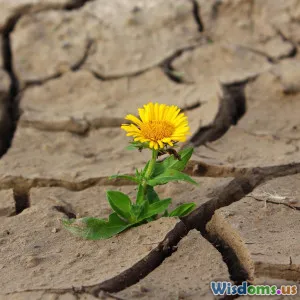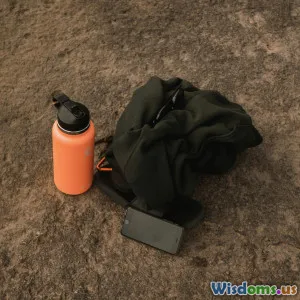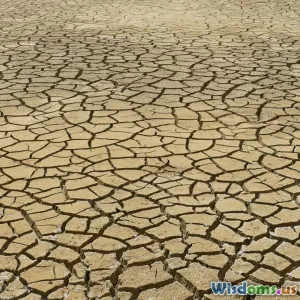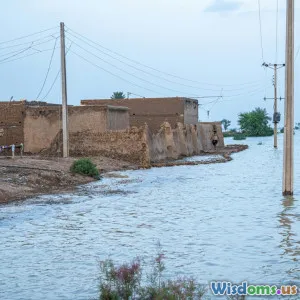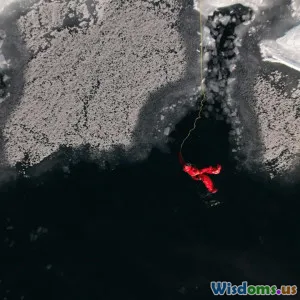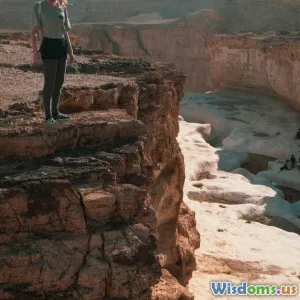
How to Find Water in Empty Desert Landscapes
16 min read Discover expert strategies to source water in barren deserts, blending science, survival stories, and practical techniques for anyone facing a harsh, arid wilderness. (0 Reviews)
How to Find Water in Empty Desert Landscapes
Introduction: Parched in the Unknown
Picture endless dunes shimmering with heat by day and chilled silence at night. It’s a landscape both mesmerizing and menacing: the desert. One of the greatest threats here is not what is visible, but what is absent—water. For the unprepared, a lack of water can rapidly escalate from discomfort to disaster. With the Sahara, the Arabian, and deserts spanning every continent, understanding how to locate life-sustaining water in these harsh regions is a key survival skill and, in many cases, a matter of life or death.
But how can one hope to find water in places that appear barren and bone-dry? This article reveals not just time-tested techniques, but little-known tips, real stories, and scientific insights. Whether you're an adventurer, trekker, rescue worker, or someone interested in extreme environments, equipping yourself with these strategies can spell the difference between hope and hardship.
Understanding the Desert’s Water Paradox
Oases sprinkled across dunes may conjure dreams of lush life amid the sands, but most of the world’s deserts offer only the illusion of emptiness. Deserts are characterized by minimal rainfall—usually less than 250 mm (10 inches) per year. Yet, even these arid expanses sometimes hide water sources, cleverly masked by nature. Scientists classify deserts as “arid” or “hyperarid” zones, both of which test every assumption about survival.
Perhaps the greatest survival story emphasizing this paradox is that of Mauro Prosperi, a marathon runner who became lost during the 1994 Marathon des Sables. Despite encountering seemingly unbeatable odds and traversing the vast emptiness of the Sahara, Prosperi survived by applying resourceful water-finding techniques—drinking his own urine, collecting morning dew, and even squeezing moisture from plants and insects.
Understanding the desert’s hidden hydrology—whether in Africa’s Sahara, Australia’s Outback, or America’s Sonoran—is foundational. Let’s explore these secrets step by step.
Signs of Water in Barren Terrain
1. Changes in Vegetation
“Where there is green, there is water”—a maxim repeated in many survival guides. Look for:
- Contrasting Vegetation: In most barren environments, patches of greener, denser plants hint at underground moisture. For example, willows, reeds, or tamarisks signal higher groundwater levels.
- Tall Trees or Shrubs: Even in desert riverbeds, deep-rooted trees (like mesquite in the US Southwest) tap hidden water below.
Example: In the Negev Desert, Israel, researchers note that Acacia trees often survive only where subsurface water trickles beneath seasonal wadis (dry riverbeds), while surrounding flora withers away.
2. Animal Activity
Animals—masters of survival—are often drawn to water far before humans know it exists. Look for:
- Bird and Insect Patterns: Bees rarely fly over a few miles from water; dense bee or ant activity may indicate a source nearby. Similarly, birds in desert heat, especially in early morning or dusk, signal the proximity of water.
- Tracks and Trails: Herds of antelope, camels, or even smaller mammals often create well-worn paths leading to waterholes, especially near dawn or dusk. Crisscrossed trails converging into one direction often lead to a water source.
Case Insight: In Namibia’s Namib Desert, locals have long relied on following the flight paths of doves and pigeons in predawn hours to hidden springs between dunes.
3. Landscape Clues
Certain landforms tend to favor water retention:
- Dry Riverbeds (Wadis/Arroyos): Though often bone-dry above ground, digging in the sand of a meandering riverbed—especially at outside curves or at the base of surface boulders—often yields damp sand just a few feet down. If damp, further digging may yield seeping water.
- Rock Overhangs & Cliffs: Water seeps through cracks in rocks, forming small pools or “seeps” beneath overhangs. Shaded side of hills may protect these from rapid evaporation.
- Natural Cavities and Caves: Cavities at the base of slopes, hills, or rocky outcrops sometimes collect rainwater, even months after a storm.
Scientific Note: A study in the Sonoran Desert found that natural seeps and springs occurred with greatest frequency along fault lines and at the base of volcanic formations that funneled rainwater underground, releasing it gradually across the dry months.
4. Desert Dew and Condensation
Desert nights, contrary to daytime heat, cool quickly. This temperature drop can yield precious dew:
- Collecting Dew: Spread a cloth, shirt, or other fabric over rocks or shrubs in the evening. At dawn, squeeze accumulated dew into a container. While minimal, this moisture can help in dire circumstances.
Real World Method: The Australian Aboriginal Waru technique uses the night’s temperature changes. Waru hunters stretch out animal skins or clothing on stones overnight; dew withdrawn at dawn is considered sacred, life-giving moisture.
Practical Water-Finding Techniques
No single method is guaranteed; always combine tactics for better results. Here are the most effective, science-backed approaches tailored for different desert types.
1. Digging for Awg (Underground Water)
Steps:
- Survey the Area: Focus on low-lying spots, dry stream beds, or near apparent green patches.
- Test for Moisture: Using a stick or hands, probe a small area. Check for cool, damp sand.
- Digging: If dampness is found, dig a pit 1–3 feet deep. Line it with rocks or sand to prevent collapse. Allow water to seep in slowly; collect with absorbent cloth or vessel.
Example: The Bedouins of the Middle East have survived by reading subtler cues in riverbeds, saying: “A patch of wild mint means water is whispering beneath the sand.”
Caution: Avoid stagnant or foul-smelling pools. Contaminated water can introduce deadly pathogens and worsen dehydration.
2. Solar Still Construction
A solar still is a reliable, field-tested method leveraging solar radiation to induce evaporation and condensation—easy to build but slow to yield water.
How to Build:
- Dig a pit in moist soil (sun-exposed spot if possible).
- Place a container in the center.
- Arrange leafy vegetation in the pit around the container (to increase moisture output).
- Cover pit with clear plastic sheet; seal edges with sand/rocks.
- Place a small stone in the center of the plastic, creating a dip over the container.
Science: Solar energy evaporates moisture, which then condenses and drips into the container. Each day in intense sunlight, a 1m² still may produce up to 1 liter.
Fact: American G.I.s in the WWII North African campaigns were trained to build solar stills as a last-resort water strategy.
3. Plant Transpiration Bags
Plants transpire—lose water vapor—through their leaves’ pores. By enclosing branches with a clear plastic bag, you create a mini-greenhouse, collecting condensed spit as drinkable liquid. Use non-toxic, succulent or leafy plants only. (Cacti and some desert shrubs may be toxic; never consume unknown flora.)
4. Exploiting Desert Succulents
Certain plants store water as sap or gel in their tissues. While not always palatable (some are bitter or mildly toxic), several are safe:
- Prickly Pear Cactus (Opuntia): Remove the spines and skin, and the pulp can be chewed to extract fluids.
- Barrel Cactus: Some species, like the Fishhook Barrel (not the ‘spined’ varieties), can provide drinkable juice in extreme emergencies. However, others can induce nausea or diarrhea—reference a field guide before attempting.
“Always test the plant by rubbing juice on your lips and waiting—irritation may signal toxicity,” recommends Dr. Isabelle Warren, field botanist with the Global Survival Institute.
Insect and Animal-Derived Moisture
Some indigenous societies have long utilized insects for hydration:
- Termite Mounds: Termites carry internal moisture, and their mounds often cap damp earth. Digging at the shaded base after rain may provide a water source.
- Grubs and Larvae: In survival situations, the liquids in certain large grubs are consumed for both water and nutrients, particularly among Aboriginal Australians.
Harvesting and Conserving Water in Deserts
1. Water Conservation Principles
- Travel at Night: Move during dusk, dawn, or night to reduce sweating and water loss.
- Shade and Rest: Shelter under rocks or make a simple shade structure during peak heat (10 AM – 4 PM).
- Minimize Exertion: Stay calm and avoid unnecessary movement.
- Clothing: Cover skin with loose, light clothing to decrease evaporation while offering protection from sunburn.
2. Purification: Never Compromise on Safety
Found water may harbor bacteria, viruses, or parasites, especially if animals drink from the source. Methods of purification include:
- Boiling (if possible): Bring water to a boil for at least one minute.
- Filtration/Sterilization Tablets: Carry water purification tablets or compact filters designed for hiking/emergencies.
- Solar Disinfection (SODIS): Fill clear water bottles and place in direct sunlight for 6-10 hours. Solar UV can inactivate many harmful microorganisms.
Quote: “Hydration without purification is a risky gamble,” says Ray Mears, British survival expert. “You must always treat found water as suspect until proven otherwise.”
Real-World Desert Survival: Lessons from the Experienced
Surviving the desert is not a theoretical exercise—hundreds of documented cases, from lost motorists to Saharan trekkers, fuel both caution and inspiration.
-
Case Study: Ricky Megee (Australia, 2006) Megee, stranded for 71 days in the Tanami Desert after his car broke down, survived by digging for water at dried riverbeds, sheltering from heat, and eating insects. His ordeal underscores the power of perseverance and the criticality of small water sources—each pool, no matter how insignificant, prolonged his survival.
-
Case Study: Joshua Tree National Park Rangers report that visiting hikers lost yearly often rely on shallow desert springs or seeps. The park’s backcountry water caches are hidden from plain sight intentionally—appreciating that surface water is both scarce and quickly vanishes in hot wind.
Innovations and Technology: Modern Desert Water Solutions
While survival techniques remain timeless, technological advances now contribute unique advantages:
- Portable Desalination Straws: Lightweight filtration devices let users drink directly from dirty or salty puddles, removing 99.9% of pathogens.
- Atmospheric Water Generators (AWGs): While still too heavy for most hikers, these machines extract water from humid air—even in relatively dry desert climates.
Fact: At Israel’s Ramon Crater, modern field researchers often use small solar panels powering AWGs to supplement traditional water sourcing—carrying proof that science is as essential as instinct.
What Not To Do: Debunking Dangerous Water Myths
Survival legend is littered with poor advice. Remember:
- Never Drink Untreated Urine (Except Only As Last Resort): It hastens dehydration in the long run.
- Avoid Salt Water: Consuming salty or brackish water causes kidney failure faster than dehydration alone.
- Don't Rely on Eating Cacti Wholesale: Many species in North American or African deserts are hallucinogenic or toxic, worsening dehydration.
Quote: “In the desert, myths kill more surely than the heat,” cautions Les Stroud (‘Survivorman’ television series).
Conclusion: The Art and Science of Desert Hydration
Finding water in deserted, arid landscapes demands a fusion of hydrological understanding, practical breadcrumbs, scientific improvisation, and above all, an unbreakable survival mindset.
Equipped with this knowledge—observing landscape, utilizing wildlife cues, building improvised collection systems, and never overlooking purification—anyone traversing the desert is better armed against its greatest foe. Survival in these extremes is not about wrestling the environment, but about learning to read its silent language.
Remember: Preparation is key. Study local plants and terrain before venturing into any desert. Carry more water than you imagine necessary—and, when faced with the cruel calculus of thirst, recall the timeless wit and wisdom survivalists have carved into the annals of desert lore.
Final Call to Action:
If you are planning desert travel, practice identifying water sources on maps, learn to recognize plant and terrain clues, and rehearse your water-gathering techniques before setting forth. In the classroom or in the wild, readiness is your greatest survival tool.
Rate the Post
User Reviews
Popular Posts










